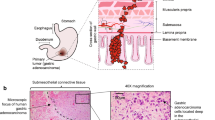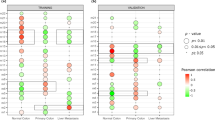Abstract
Interleukin (IL)-10 has potent biological properties including an inhibitory action on the proliferation and metastasis of various cancer cells. However, it is difficult to maintain a high concentration of this cytokine as it has a short half life. In this study, we evaluated whether peritoneal mesothelial cells (PMCs) could be suitable for maintaining a high concentration of IL-10 using adenoviral gene transfer. We also evaluated the therapeutic effects of an intraperitoneal injection with adenoviral vector containing mouse IL-10 gene (Ad-mIL-10) using a mouse peritoneal dissemination model of MKN45 gastric cancer cells. We demonstrated that in vitro transfection efficiency of a recombinant adenovirus containing the bacterial β-galactosidase gene (Ad-LacZ) was approximately 10-fold higher for primarily isolated PMCs than MKN45. The entire peritoneum was transfected until 3 weeks after an intraperitoneal Ad-LacZ injection. Ad-mIL-10 treatment increased intraperitoneal IL-10 levels until 3 weeks after treatment, and then significantly inhibited peritoneal cancer growth by inhibiting angiogenesis. This treatment also improved cachexia and prolonged mice survival. We thus concluded that IL-10 gene transfer in PMCs could be a new strategy for the prevention of peritoneal dissemination of gastric cancer due to the resulting persistently high IL-10 concentration in the peritoneal cavity.
This is a preview of subscription content, access via your institution
Access options
Subscribe to this journal
Receive 12 print issues and online access
$259.00 per year
only $21.58 per issue
Buy this article
- Purchase on SpringerLink
- Instant access to full article PDF
Prices may be subject to local taxes which are calculated during checkout






Similar content being viewed by others
References
Fiorentino DF, Bond MW, Mosmann TR . Two types of mouse helper T cell. IV. Th2 clones secrete a factor that inhibits cytokine production by Th1 clones. J Exp Med 1989; 170: 2081–2095.
de Waal Malefyt R, Haanen J, Spits H, Roncarolo MG, te Velde A, Figdor C et al. Interleukin 10 (IL-10) and viral IL-10 strongly reduce antigen-specific human T cell proliferation by diminishing the antigen-presenting capacity of monocytes via downregulation of class II major histocompatibility complex expression. J Exp Med 1991; 174: 915–924.
Fiorentino DF, Zlotnik A, Mosmann TR, Howard M, O'Garra A . IL-10 inhibits cytokine production by activated macrophages. J Immunol 1991; 147: 3815–3822.
Bogdan C, Vodovotz Y, Nathan C . Macrophage deactivation by interleukin 10. J Exp Med 1991; 174: 1549–1555.
Huang S, Ullrich SE, Bar-Eli M . Regulation of tumor growth and metastasis by interleukin-10: the melanoma experience. J Interferon Cytokine Res 1999; 19: 697–703.
Cervenak L, Morbidelli L, Donati D, Donnini S, Kambayashi T, Wilson JL et al. Abolished angiogenicity and tumorigenicity of Burkitt lymphoma by interleukin-10. Blood 2000; 96: 2568–2573.
Kohno T, Mizukami H, Suzuki M, Saga Y, Takei Y, Shimpo M et al. Interleukin-10-mediated inhibition of angiogenesis and tumor growth in mice bearing VEGF-producing ovarian cancer. Cancer Res 2003; 63: 5091–5094.
Stearns ME, Rhim J, Wang M . Interleukin 10 (IL-10) inhibition of primary human prostate cell-induced angiogenesis: IL-10 stimulation of tissue inhibitor of metalloproteinase-1 and inhibition of matrix metalloproteinase (MMP)-2/MMP-9 secretion. Clin Cancer Res 1999; 5: 189–196.
Kundu N, Beaty TL, Jackson MJ, Fulton AM . Antimetastatic and antitumor activities of interleukin 10 in a murine model of breast cancer. J Natl Cancer Inst 1996; 88: 536–541.
Zheng LM, Ojclus DM, Garaud F, Roth C, Maxwell E, Li Z et al. Interleukin-10 inhibits tumor metastasis through an NK cell-dependent mechanism. J Exp Med 1996; 184: 579–584.
Berman RM, Susuki T, Tahara H, Robbins PD, Narula SK, Lotze MT . Systemic administration of cellular IL-10 induces an effective, specific, and long-lived immune response against established tumors in mice. J Immunol 1996; 157: 231–238.
Kundu N, Fulton AM . Interleukin-10 inhibits tumor metastasis, downregulates MHC class I, and enhances NK lysis. Cell Immunol 1997; 180: 55–61.
Di Carlo E, Coletti A, Modesti A, Giovarelli M, Forni G, Musiani P . Local release of interleukin-10 by transfected mouse adenocarcinoma cells exhibits pro- and anti-inflammatory activity and results in a delayed tumor rejection. Eur Cytokine Netw 1998; 9: 61–68.
Kundu N, Dorsey R, Jackson MJ, Guiterrez P, Wilson K, Fu S et al. Interleukin-10 gene transfer inhibits murine mammary tumors and elevates nitric oxide. Int J Cancer 1998; 76: 713–719.
Moore KW, de Waal Malefyt R, Coffman RL, O'Garra A . Interleukin-10 and the interleukin-10 receptor. Annu Rev Immunol 2001; 19: 683–765.
Chernoff AE, Granowitz EV, Shapiro L, Vannier E, Lonnemann G, Angel JB et al. A randomized, controlled trial of IL-10 in humans. Inhibition of inflammatory cytokine production and immune responses. J Immunol 1995; 154: 5492–5499.
Kokura S, Yoshida N, Ishikawa T, Higashihara H, Sakamoto N, Takagi T et al. Interleukin-10 plasmid DNA inhibits subcutaneous tumor growth of Colon26 adenocarcinoma in mice. Cancer Lett 2005; 218: 171–179.
Benevolo M, Mottolese M, Cosimelli M, Tedesco M, Giannarelli D, Vasselli S et al. Diagnostic and prognostic value of peritoneal immunocytology in gastric cancer. J Clin Oncol 1998; 16: 3406–3411.
Gosselin R, Berndt W . Diffusional transport of solutes through mesentery and peritoneum. J Theor Biol 1962; 3: 487.
Topley N, Jorres A, Luttmann W, Petersen MM, Lang MJ, Thierauch KH et al. Human peritoneal mesothelial cells synthesize interleukin-6: induction by IL-1β and TNF α. Kidney Int 1993; 43: 226–233.
Betjes MG, Tuk CW, Struijk DG, Krediet RT, Arisz L, Hart M et al. Interleukin-8 production by human peritoneal mesothelial cells in response to tumor necrosis factor-α, interleukin-1, and medium conditioned by macrophages cocultured with Staphylococcus epidermidis. J Infect Dis 1993; 168: 1702–1710.
Lanfrancone L, Boraschi D, Ghiara P, Falini B, Grignani F, Peri G et al. Human peritoneal mesothelial cells produce many cytokines (granulocyte colony-stimulating factor [CSF], granulocyte-monocyte-CSF, macrophage-CSF, interleukin-1 [IL-1], and IL-6) and are activated and stimulated to grow by IL-1. Blood 1992; 80: 2835–2842.
Jayne DG, Perry SL, Morrison E, Farmery SM, Guillou PJ . Activated mesothelial cells produce heparin-binding growth factors: implications for tumour metastasis. Br J Cancer 2000; 82: 1233–1238.
Sako A, Kitayama J, Yamaguchi H, Kaisaki S, Suzuki H, Fukatsu K et al. Vascular endothelial growth factor synthesis by human omental mesothelial cells is augmented by fibroblast growth factor-2: possible role of mesothelial cell on the development of peritoneal metastasis. J Surg Res 2003; 115: 113–120.
Balabanian K, Foussat A, Bouchet-Delbos L, Couderc J, Krzysiek R, Amara A et al. Interleukin-10 modulates the sensitivity of peritoneal B lymphocytes to chemokines with opposite effects on stromal cell-derived factor-1 and B-lymphocyte chemoattractant. Blood 2002; 99: 427–436.
Sako A, Kitayama J, Koyama H, Ueno H, Uchida H, Hamada H et al. Transduction of soluble Flt-1 gene to peritoneal mesothelial cells can effectively suppress peritoneal metastasis of gastric cancer. Cancer Res 2004; 64: 3624–3628.
Fujikawa K, Takai K, Suga A, Naito K, Ohata A, Nakasone S et al. Expression of mRNA for growth factors and extracellular matrix proteins after injury to cultured peritoneal cells: does the healing process contribute to peritoneal ultrastructural alteration? J Artif Organs 2003; 6: 253–259.
Robson RL, McLoughlin RM, Witowski J, Loetscher P, Wilkinson TS, Jones SA et al. Differential regulation of chemokine production in human peritoneal mesothelial cells: IFN-γ controls neutrophil migration across the mesothelium in vitro and in vivo. J Immunol 2001; 167: 1028–1038.
Takakuwa T, Endo S, Shirakura Y, Yokoyama M, Tamatani M, Tohyama M et al. Interleukin-10 gene transfer improves the survival rate of mice inoculated with Escherichia coli. Crit Care Med 2000; 28: 2685–2689.
Kuwamura H, Tominaga K, Shiota M, Ashida R, Nakao T, Sasaki E et al. Growth inhibition of colon cancer cells by transfection of dominant-negative apoptosis signal-regulating kinase-1. Oncol Rep 2007; 17: 781–786.
Suto R, Tominaga K, Mizuguchi H, Sasaki E, Higuchi K, Kim S et al. Dominant-negative mutant of c-Jun gene transfer: a novel therapeutic strategy for colorectal cancer. Gene Ther 2004; 11: 187–193.
Fujiki F, Mukaida N, Hirose K, Ishida H, Harada A, Ohno S et al. Prevention of adenocarcinoma colon 26-induced cachexia by interleukin 10 gene transfer. Cancer Res 1997; 57: 94–99.
Giovarelli M, Musiani P, Modesti A, Dellabona P, Casorati G, Allione A et al. Local release of IL-10 by transfected mouse mammary adenocarcinoma cells does not suppress but enhances antitumor reaction and elicits a strong cytotoxic lymphocyte and antibody-dependent immune memory. J Immunol 1995; 155: 3112–3123.
Zeni F, Tardy B, Vindimian M, Comtet C, Page Y, Cusey I et al. High levels of tumor necrosis factor-alpha and interleukin-6 in the ascitic fluid of cirrhotic patients with spontaneous bacterial peritonitis. Clin Infect Dis 1993; 17: 218–223.
Zebrowski BK, Liu W, Ramirez K, Akagi Y, Mills GB, Ellis LM . Markedly elevated levels of vascular endothelial growth factor in malignant ascites. Ann Surg Oncol 1999; 6: 373–378.
Acknowledgements
This study was supported in part by a Grant-in Aid for Scientific Research from the Ministry of Education, Culture, Sports Science and Technology of Japan and the Yasuda Medical Foundation.
Author information
Authors and Affiliations
Corresponding author
Rights and permissions
About this article
Cite this article
Tanaka, F., Tominaga, K., Shiota, M. et al. Interleukin-10 gene transfer to peritoneal mesothelial cells suppresses peritoneal dissemination of gastric cancer cells due to a persistently high concentration in the peritoneal cavity. Cancer Gene Ther 15, 51–59 (2008). https://doi.org/10.1038/sj.cgt.7701104
Received:
Revised:
Accepted:
Published:
Issue date:
DOI: https://doi.org/10.1038/sj.cgt.7701104
Keywords
This article is cited by
-
Lister strain vaccinia virus with thymidine kinase gene deletion is a tractable platform for development of a new generation of oncolytic virus
Gene Therapy (2015)
-
Functionalized Scaffold-mediated Interleukin 10 Gene Delivery Significantly Improves Survival Rates of Stem Cells In Vivo
Molecular Therapy (2011)



